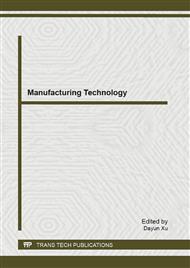[1]
Yang Li, Advanced Optical Machining Technique, Science Press, Beijing, (2001).
Google Scholar
[2]
J. E. DeGroote, Surface interactions between nanodiamonds and glass in magnetorheological finishing (MRF), Ph.D. dissertation, University of Rochester, (2007).
Google Scholar
[3]
Arrasmith S R, Kozhinova I A, Gregg L L, et al, Details of polishing spot in magnetorheological finishing, Proc. SPIE, 3782: 92-99. (1993).
Google Scholar
[4]
C. Miao, S. N. Shafrir, J. C. Lambropoulos, J. Mici, and S. D. Jacobs, Shear stress in magnetorheological finishingfor glasses, Appl. Opt. 48, 2585–2594. (2009).
DOI: 10.1364/ao.48.002585
Google Scholar
[5]
M. Schinhaerl, E. Pitschke, A. Geiss, R. Rascher, P. Sperber, R. Stamp, L. Smith, and G. Smith, Com-parison of different magnetorheological polishing fluids, SPIE, 5965: 659–670. (2005).
DOI: 10.1117/12.656430
Google Scholar
[6]
Zhang Feng, Zhang Xuejun, Yu Jingchi, Wang Quandou, Guo Peiji, Foundation of mathematics model of magnetorheological finishing, Optical Technique, 26(2): 190-192. (2000).
Google Scholar
[7]
Sun Xiwei, Han Qiang, Yu Dayong, Liu Sheng, Magnetorheological Finishing Dwell Time Algorithm, Opto-Electronic Engineering, 36(1), 114-119. (2009).
Google Scholar
[8]
Kang Guiwen, Zhang Feihu, Dong Shen, Research on magnetorheological fluid and application in optical machining, Optical Technique, 30(3), 354-356. (2004).
Google Scholar
[9]
Zheng Nan, Li Haibo, Yuan Zhigang, Zhong Bo, Control software development for magnetorheological finishing of large aperture optical elements, High Power Laser And Particle Beams, 23(2), 419-422. (2011).
DOI: 10.3788/hplpb20112302.0419
Google Scholar
[10]
J. A. Menapace, P. J. Davis, W. A. Steele, M. R. Hachkowski, A. Nelson, K. Xin, MRF applications: on the road to making large-aperture ultraviolet laser resistant continuous phase plates for high-power lasers, Laser Induced Damage in Optical Materials: Proc. SPIE, 6403, 64030N . (2006).
DOI: 10.1117/12.696329
Google Scholar
[11]
J. A. Menapace, P. J. Davis, S. Dixit, J. H. Campbell, D. Golini, M. R. Hachkowski, A. Nelson, Imprinting continuously varying topographical structure onto large-aperture optical surfaces using magnetorheological finishing, Proc. euspen, II, 181-184. (2007).
Google Scholar


